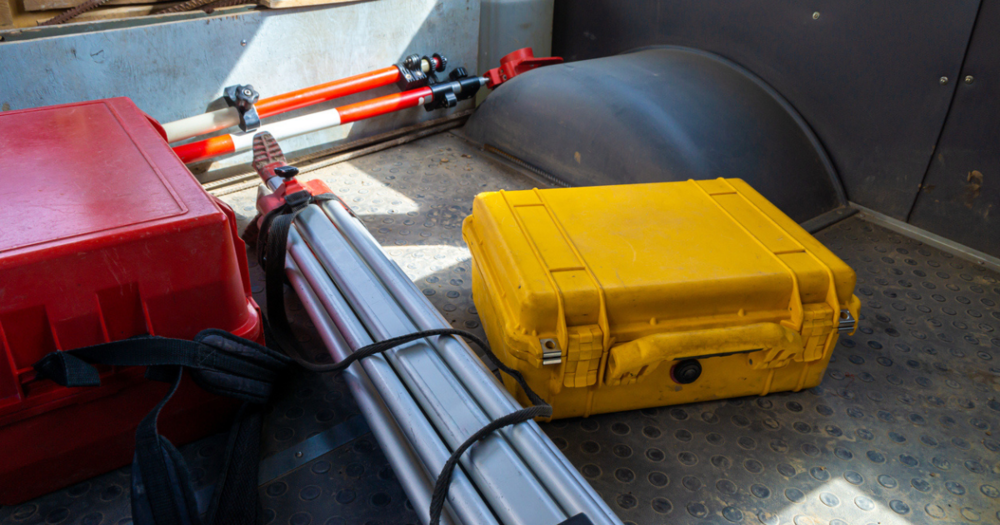
Understanding the various cost factors is essential for making informed purchasing decisions when equipping your surveying team with the necessary
GPS land surveying tools.
However, budgeting for GPS surveying equipment involves more than the initial purchase price. It encompasses a range of ongoing expenses and accessory costs that impact your overall investment.
Let’s break down these costs so you can allocate your resources effectively.
Cost Factors in GPS Surveying Equipment
Planning a budget for GPS surveying equipment requires considering various cost factors beyond the initial purchase. These costs can significantly impact your surveying operations' expenses and efficiency.
- Initial purchase costs: When considering the budget for GPS surveying equipment, it's essential to account for the initial purchase cost of the primary GPS device.
- Accessories and additional equipment: In addition to the primary GPS devices, you often need extra equipment. This includes antennae and mounts, data collectors, batteries and chargers, and protective cases.
- Ongoing costs: It's also essential to consider ongoing costs such as maintenance, repairs, software, subscription fees, customer support, and training. These recurring expenses can add up over time and should be factored into the long-term budget planning.
Initial Purchase Costs
When budgeting for GPS surveying equipment, it is important to understand the different types of systems available and their associated costs.
Here are the three main types of GPS survey equipment:
Handheld GPS Units
Basic
handheld GPS units are designed for general navigation and basic surveying tasks. These portable devices are user-friendly and provide a practical solution for those needing straightforward positional data.
- Depending on the brand, accuracy, and additional features (such as weather resistance and battery life), they typically cost between $100 and $1,500.
Handheld GPS units are ideal for less demanding surveying applications, such as preliminary site assessments and GIS data collection.
Read
Handheld GPS Units vs. Total Stations and GNSS vs GPS: Examining the Differences for more information.
Differential GPS (DGPS) Systems
DGPS systems enhance the accuracy of standard GPS by using a network of fixed ground-based reference stations. These systems correct GPS signals, significantly improving positional accuracy to sub-meter levels.
- Prices for DGPS systems generally range from $2,000 to $10,000.
- The cost varies based on factors like the number of reference stations, the quality of the equipment, and the applications intended for the system.
DGPS systems are well-suited for more precise surveying needs, including
construction site layouts, agriculture, and marine navigation.
Read
What Is the Difference Between GPS and DGPS for a deeper dive.
Real-Time Kinematic (RTK) Systems
RTK systems provide the highest level of accuracy among GPS systems by utilizing real-time corrections from a base station to the rover (the mobile unit). RTK systems are essential for surveyors who need the utmost accuracy and reliability in their measurements.
- RTK systems typically cost between $8,000 and $30,000, depending on the brand, model, and additional features (like network connectivity and software compatibility).
- Factors influencing the price include the quality of the base station, the number of rovers, and the intended precision level.
RTK systems can achieve centimeter-level accuracy, making them ideal for applications that require precise measurements, such as land surveying, civil engineering, and autonomous vehicle guidance.
Read
Guide to Real-Time Kinematic (RTK) Surveying for more information.
Accessories and Additional Equipment

In addition to the primary GPS surveying equipment, several accessories are needed for optimal performance and accuracy. These include:
- Data collectors: Portable devices store and manage the data collected during surveys. They facilitate real-time data analysis and integration with other systems.
- Antennas: Used to improve signal reception and stability, critical for maintaining accuracy.
- Mounts: Necessary for securely attaching GPS devices to various surfaces for steady positioning during data collection.
- Batteries and power sources: Essential so that equipment operates without interruption during fieldwork.
- Protective cases: Designed to safeguard sensitive equipment from damage during transport and field operations. Check out How to Protect Your Surveying Equipment.
- Tripods: They provide stable support for GPS devices, especially in uneven terrain or long-duration surveys. For more information, read Important Considerations When Choosing Surveying Tripods.
Cost Implications of Add-Ons
The costs associated with these essential accessories can add up quickly but are necessary for maximizing the capabilities of your GPS surveying equipment. Here’s a general cost breakdown:
- Data collectors: Prices range from $1,000 to $5,000, depending on features and brand.
- Antennas: Can range from $200 to $1,000.
- Mounts: Generally cost between $50 and $500, varying based on the type and material.
- Batteries and power sources: Backup batteries and power supplies range from $50 to $300, depending on capacity and brand.
- Protective cases: The cost varies from $100 to $500, depending on the level of protection and size.
- Tripods: Typically cost between $100 and $500.
Check out a range of
GPS accessory options available at Baseline Equipment.
Ongoing Costs and Considerations
It's essential to look beyond the initial price of the GPS surveying equipment and consider the ongoing costs that will affect your overall investment.
Maintenance and Repairs
Proper maintenance and repairs provide longevity and reliability, ultimately protecting your investment and minimizing downtime.
Regular Maintenance
Regular maintenance involves routine checks and calibrations to increase accuracy and functionality. It helps prevent unexpected breakdowns and extends the lifespan of equipment.
Key maintenance activities include:
- Cleaning and inspection: Regularly inspect the equipment for wear and tear.
- Software updates: Verify the latest firmware and software versions are installed.
- Calibration: Periodically calibrate the equipment for better accuracy and reliability.
Estimated Costs for Common Repairs
Despite regular maintenance, occasional repairs will be necessary due to wear and tear or accidental damage. Common repairs and their estimated costs include:
- Battery replacement: Typically costs around $100 to $300.
- Antenna repair/replacement: Can range from $200 to $1,000 depending on the model and extent of the damage.
- Screen or display repairs: Usually cost between $150 and $500.
- Internal component repairs: More complex repairs (like those involving internal circuitry) can range from $500 to $2,000.
Check out
How to Extend the Lifespan of Your Land Surveying Equipment for additional help.
Software Licensing and Updates
Beyond the hardware costs, software licensing and updates are important factors to consider for maintaining the efficiency and accuracy of GPS surveying equipment.
Proper software keeps your equipment functioning optimally and current with the latest technological advancements.
Costs Associated with Surveying Software
The costs associated with this software can vary widely based on the functionalities required and the licensing model chosen. Typical fees might include:
- Basic software packages: These can range from $500 to $2,000. They offer essential tools for data collection and basic processing.
- Advanced software suites: Comprehensive packages that include advanced processing, 3D modeling, and integration with other systems can cost between $5,000 and $15,000.
When selecting surveying software, you’ll choose between subscription-based models and one-time purchases.
Subscription Options
- Monthly or annual fees: Subscriptions typically involve recurring monthly or yearly payments, ranging from $50 to $200 per month, depending on the software and features included.
- Continuous updates: Subscription models usually provide regular updates and new features, providing access to the latest advancements and improvements.
- Support and maintenance: Many subscriptions include customer support and maintenance services.
One-Time Purchase Options
- Single payment: A one-time purchase involves a single upfront payment, which can be cost-effective in the long term if the software meets all your needs.
- Limited updates: These models might include only a limited period of free updates, after which additional fees may apply for major upgrades.
- Ownership: You retain ownership of the software indefinitely, reducing ongoing costs.
Both options have advantages, and the choice depends on your specific needs, budget, and preference for ongoing versus upfront costs.
Do all GPS trackers require a monthly fee?
Not all GPS devices require a monthly subscription fee. Basic handheld GPS units typically do not incur monthly charges.
However, advanced GPS tracking solutions often require subscriptions to access real-time kinematic (RTK) correction services, satellite-based augmentation systems (
SBAS), or cloud-based data management platforms.
Equipment Customer Support Services
Access to reliable customer support is essential for resolving technical issues and providing uninterrupted project workflows. Customer support services assist with technical troubleshooting, operational guidance, and software updates.
The availability and cost of these services can vary:
- Included support: Some equipment purchases come with complimentary support (e.g., six months to one year).
- Extended support plans: Extended support plans can be purchased separately, and their costs range from $200 to $1,000 per year, depending on the level of service and response times required.
Training and Continuing Education
Proper training guarantees you can optimize accuracy, increase productivity, and reduce errors.
Investment in Initial Training
Proper training includes understanding how to operate the devices, interpret the data, and troubleshoot common issues.
- Equipment manufacturers, third-party providers, or internal company resources can offer training programs.
- Depending on the depth and duration of the program, training session costs can range from $500 to $2,000 per session.
Certifications and Continued Education
Surveying professionals may also need to obtain certifications or pursue continued education to stay updated with standards and best practices.
Costs related to certifications and continuing education include:
- Certification programs: Fees for certification courses and exams can range from $200 to $1,000 per certification.
- Workshops and seminars: Participation in industry workshops and seminars for ongoing education can cost between $300 and $1,500 per event.
- Online courses: Many online platforms offer specialized courses in surveying techniques and technologies, varying costs from $100 to $500 per course.
Assessing Project Needs and Choosing Appropriate Equipment

A well-considered budget begins with a clear assessment of the specific needs of your projects. Understanding the scope, required accuracy, and environmental conditions will guide you in choosing the most suitable GPS surveying equipment.
- Project scope: Determine the scale and complexity of the surveys. Basic handheld GPS units may suffice for small-scale or less demanding tasks. For more complex projects requiring high precision, consider investing in RTK or DGPS systems.
- Required accuracy: Identify the level of accuracy needed. High-accuracy systems like RTK are ideal for construction layout and boundary surveys, while basic units might be adequate for preliminary site assessments.
- Environmental conditions: Evaluate the working environment. Rugged and weatherproof designs are essential for harsh outdoor conditions, providing durability and consistent performance.
Financing Options or Leasing Equipment
Exploring financing options or leasing can provide flexibility and make advanced technology more accessible:
- Financing plans: Some suppliers offer financing plans that spread the cost over time, making it easier to manage cash flow.
- Leasing equipment: Leasing can be a cost-effective alternative, especially for short-term projects or when you need to access the latest technology without a significant upfront investment. Leasing agreements often include maintenance and support, reducing additional expenses.
Strategic Planning for Long-Term Success
Investing in the right GPS surveying equipment and accessories while accounting for all associated costs, is essential for maintaining the integrity and precision of your surveying operations.
By planning carefully and considering all aspects of cost, you can guarantee that your equipment remains reliable and effective for years to come.
Understand budgeting for GPS surveying equipment beyond initial costs, considering accessories, maintenance, and ongoing expenses for effective resource allocation.